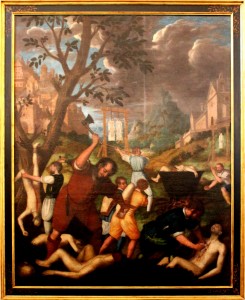 On 19 June 1535, Sebastian Newdigate, William Exmew and Humphrey Middlemore, monks of the Carthusian Order of London Charterhouse, were hanged, drawn and quartered at Tyburn. Their crime was refusing to accept King Henry VIII as the Supreme Head of the Church after his marriage to Anne Boleyn and subsequent break with Rome.
On 19 June 1535, Sebastian Newdigate, William Exmew and Humphrey Middlemore, monks of the Carthusian Order of London Charterhouse, were hanged, drawn and quartered at Tyburn. Their crime was refusing to accept King Henry VIII as the Supreme Head of the Church after his marriage to Anne Boleyn and subsequent break with Rome.
Between May 1535 and August 1540, 18 Cathusian monks were put to death for this crime, some being hanged, drawn and quartered, some being hanged in chains and others being starved to death. All 18 are recognised as martyrs by the Catholic Church.
Trivia: George Boleyn and Thomas Boleyn, along with the Duke of Norfolk, Henry Fitzroy and Henry Norris, were present at the executions of three Carthusian monks on 4 May 1535.
You can read more about the Carthusian monks in my article from last year – click here.